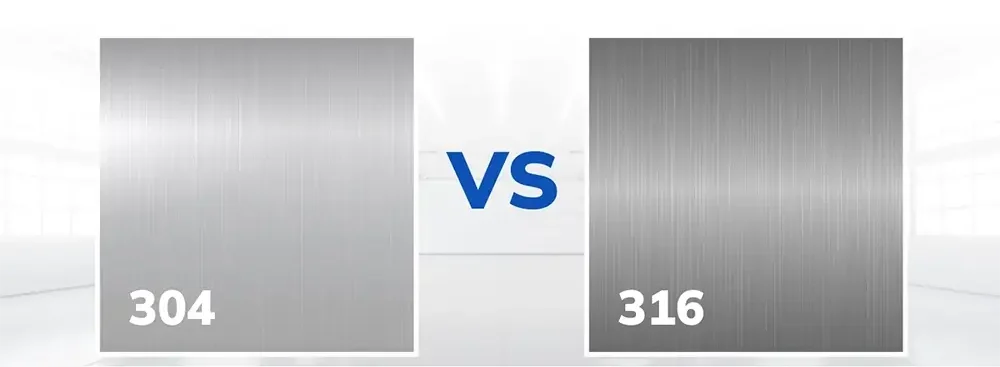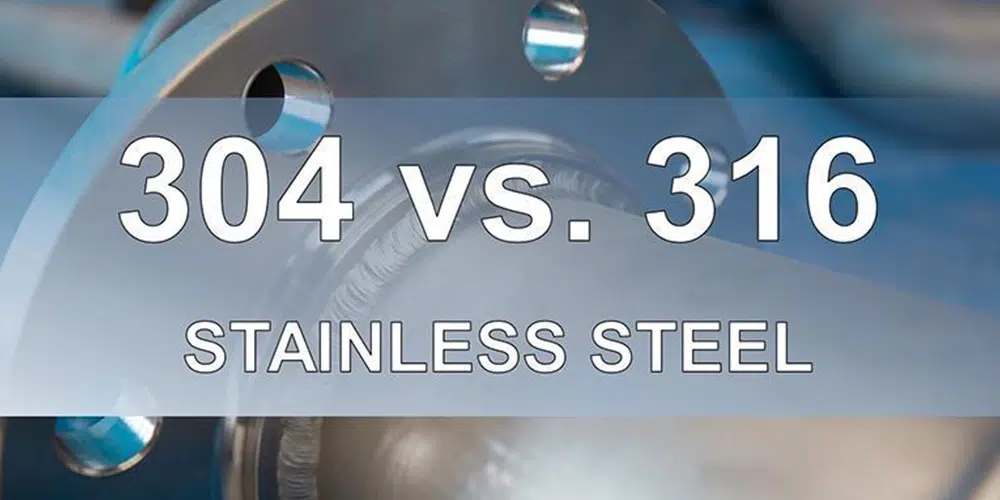In the competitive manufacturing environment at present, choosing the right grade of stainless steel is critical to the success of your organisation. Based on McKinsey’s latest market analysis and industry insights, the global stainless steel market is expected to reach $157.4 billion by 2030, with 304 and 316 stainless steels as the two most important grades, each with unique advantages, depending on the environment and requirements.
The difference:304 Vs. 316 Stainless Steel
316 and 304 stainless steels belong to austenitic stainless steel family,are the two most widely used grades in the world, provide excellent corrosion resistance.

304 Stainless Steel
Containing 16 to 24 percent chromium and small amounts of carbon and manganese, 304 stainless steel is the most common 18-8 stainless steel, which contains 18 percent chromium and 8 percent nickel.
316 Stainless Steel
Grade 316 has virtually the same physical and mechanical properties as 304 stainless steel, with the main difference being that 316 stainless steel contains 2% to 3% molybdenum, which improves corrosion resistance, especially against chlorides and other industrial solvents.
| Material Composition | 304 | 316 |
| C | ≤0.08 | ≤0.08 |
| Si | ≤1.00 | ≤1.00 |
| Mn | ≤2.00 | ≤2.00 |
| P | ≤0.045 | ≤0.045 |
| S | ≤0.030 | ≤0.030 |
| Cr | 18-20 | 16-18 |
| N | 8-10.5 | 10-14 |
| Mo | – | 2.0-3.0 |
In 304, with roughly 8% nickel, and 316, with about 10%, it stabilises the austenitic structure, ensuring the ductility and toughness critical for fabrication and high-stress applications.
Nickel also significantly boosts corrosion resistance, especially against reducing acids and chloride-induced stress-corrosion cracking.316 stainless steel also contains 2 to 3% molybdenum than 304 stainless steel, making it resistant to corrosion from chlorides, such as seawater and ice salts, outshining 304 in saline and harsh chemical environments.
Nickel plays a critical role in both 304 and 316 stainless steel, but the differences in nickel content, and the addition of molybdenum in 316 directly influence their performance under extreme conditions.
| Grade | 202 | 304 |
| Tensile Strength | ≥520 | ≥520 |
| Yield Strength | ≥205 | ≥205 |
| Extension | ≥30% | ≥35% |
| Hardness (HV) | <253 | <200 |
While both grades share similar tensile strengths and excellent stiffness (modulus of elasticity: 193–200 GPa for 304), the higher nickel (10–14%) and molybdenum (2%) significantly enhance 316 steel’s resistance to cracking, pitting, and corrosion, especially in high-pressure or chloride-rich environments.
Thermally, nickel improves stability; the composition of 316 makes it more reliable under high temperatures for prolonged times, such as in heat exchangers or chemical reactors.316 retains its strength and corrosion resistance at elevated temperatures, making it ideal for heat applications.
While 304 performs well and is more cost-effective, its lack of molybdenum makes it less ideal for harsh or fluctuating conditions.
316 shines in extreme environments, while 304 serves better in less demanding applications.
Corrosion Resistance
316 is better:
Molybdenum makes it more resistant to corrosion in chlorinated environments (seawater, brine), acidic media and high temperature environments, and its resistance to pitting and intergranular corrosion is better than that of 304.
304 is suitable for general environment:
Good corrosion resistance in daily environment, but high chlorine or acidic environment is easy to corrode.
The difference in corrosion resistance between 316 and 304 stainless steel is primarily due to their alloying elements. 316 stainless steel contains a minimum of 2.0% molybdenum, which significantly enhances its corrosion resistance, especially in chloride-rich environments, such as those found in marine applications.
The addition allows 316 to withstand exposure to salt and other corrosives far better than 304 stainless steel, which lacks molybdenum and therefore is more susceptible to pitting and crevice corrosion in salty environments
When dealing with harsher environments, particularly those that involve chlorides or acids, 316 is the superior choice, providing enhanced durability and longevity.
Mechanical Properties
Both 304 and 316 stainless steel are tough, ductile austenitic alloys. In practice, 316 often shows slightly higher tensile and yield strength due to its alloy content. For example, typical data show 316 UTS ≈79.8 ksi vs 73.2 ksi for 304, and yield ≈34.8 ksi vs 31.2 ksi.
Elongation is similar (around 60–70%). Both grades retain strength at high temperature, though 316 usually holds up a bit better at elevated temperatures.
316 stainless steel is generally recognized for its superior mechanical strength compared to 304, making it more suitable for applications requiring high tensile strength and hardness.However, 304 stainless steel exhibits greater flexibility due to its lower modulus of elasticity, which can be advantageous in specific fabrication processes
In terms of machinability, 304 stainless steel is easier to machine than 316, largely due to its lower hardness. This ease of machining can reduce tool wear and operational downtime.
When exposed to high temperatures, 304 stainless steel can withstand elevated temperatures well, but continuous use at temperatures between 425-860 °C (797-1580 °F) may lead to corrosion.In contrast,316 stainless steel maintains its strength and corrosion resistance even at elevated temperatures, making it a preferred choice for heat applications.
Cost
Grade 316 consistently carries a premium over 304. The main drivers are the alloy content – Mo and higher Ni – which are expensive and market-sensitive.In current markets, 316 typically costs about 20–30% more than 304 (varying by country and product form).
- 304 Stainless Steel: Suitable for general applications with excellent price/performance ratio.More affordable, ideal for budget-sensitive projects.
- 316 Stainless Steel: Suitable for harsh environments with excellent corrosion resistance. Higher price due to molybdenum, but worth it for durability.
Application
316 Stainless Steel
316 stainless steel is often recommended for harsh environments due to its superior corrosion resistance, particularly against chlorides and acids. This makes it ideal for marine applications, chemical processing, and environments with high salinity, such as coastal areas and swimming pools.
The addition of a minimum 2.0% molybdenum to 316 enhances its durability, allowing it to maintain strength and corrosion resistance at elevated temperatures.
304 Stainless Steel
304 stainless steel is a more cost-effective option suitable for general applications, such as kitchen sinks, saucepans, and architectural panelling, where exposure to corrosive elements is minimal.
It offers excellent corrosion resistance in various environments but lacks the specific properties needed for more demanding applications.
The choice between 316 and 304 stainless steel should be determined by the specific requirements of the application and the environmental conditions it will be exposed to.

When to choose 304 Stainless Steel
Choose grade 304 if you use it for the following items:
- Indoor or mildly corrosive environments.
- Budget constraints without compromising quality.
- Applications such as food processing or medical equipment do not require extreme corrosion resistance.
- General architectural or decorative uses
When to choose 316 Stainless Steel
Choose grade 316 if you use it for the following projects:
- Exposure to seawater or marine environments.
- Chemical processing or acidic conditions.
- High-temperature applications (such as heat exchangers).
- Scenarios requiring extra durability and long life.
Key takeaways from the McKinsey analysis
McKinsey market insights show that while both grades are versatile, their market applications differ:
- 316 dominates in sectors such as marine, chemicals and energy due to its enhanced durability.
- 304 leads in sectors such as construction, food processing and healthcare, where cost and general performance are prioritized.
Which is better,316 or 304 Stainless Steel?
Depending on project environment and budget:
- For extreme conditions, 316 is worth the investment.
- For general use, 304 offers excellent value.
Corrosion Resistance
- High corrosion risk: Choose 316 to ensure long life and perform well in harsh environments with heavy chlorides, such as marine or chemical plants.
- Mild Corrosions: Choose 304 to save costs and maintain versatility, but it doesn’t perform well in extreme corrosion.
Common Misconceptions
The idea that “316 is always better” is not entirely true. The additional corrosion resistance of 316 only makes sense in harsh environments. In indoor or mild environments, “upgrading” to 316 offers little benefit and a significant cost increase. Using 316 when 304 is sufficient may increase material and manufacturing costs without extending service life. In general: if the material will not be exposed to salt water, de-icing salts or strong acids, then 304 is usually sufficient.
Conclusion
In summary, 304 and 316 stainless steels each have their features.Grade 316 offers superior corrosion resistance (especially to chlorides) and higher strength, but at a significant price premium. Grade 304 is more cost-effective for general use and still highly corrosion-resistant in non-aggressive environments.The best choice depends on the application conditions.





